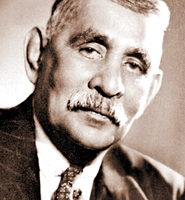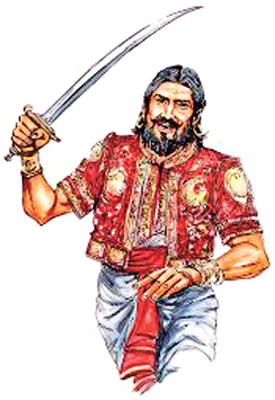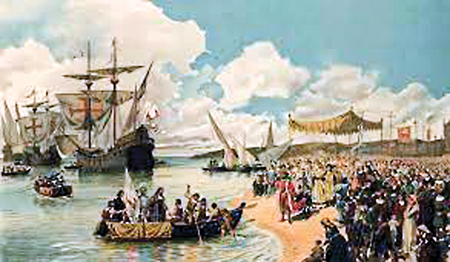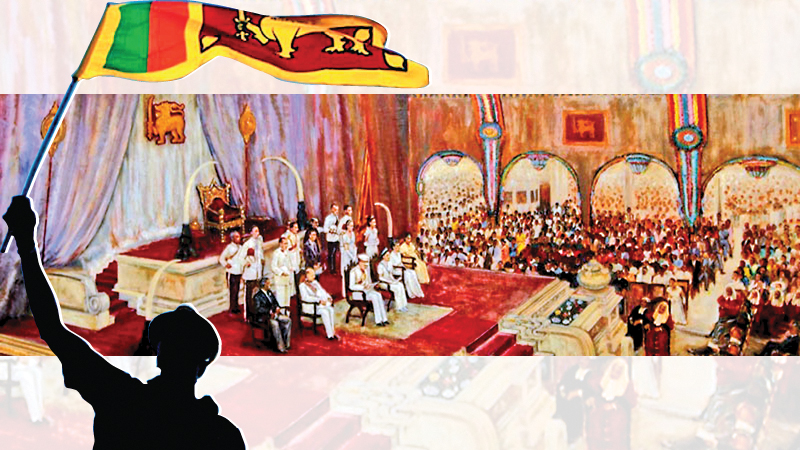Sri Lankans across the island still live freely and independently because of the lionhearted fighters for freedom Mother Lanka gave birth to more than seven decades ago. The National Day or Independence Day which falls on February 4 annually, is a day when every Sri Lankan commemorates the country’s independence from British rule in 1948.
Independence Day is celebrated through flag-hoisting ceremonies, parades, cultural and other performances which showcase the cultural traditions strengths and wealth of Sri Lanka.
The Independence Ceremony

D.S. Senanayake
Normally, this event takes place in Colombo where the President hoists the National Flag and addresses the nation.
In the President’s speech, he highlights the achievements of the Government during the past year, raises important issues and calls for further development of the country.
The President also pays
tribute to the national heroes of Sri Lanka and observes two minutes’ silence in their memory.
Military parades
A military parade is also held. The military parades showcase the power of the Army, Navy, Air Force, Police and the Civil Defence Force.
The commitment, bravery, national unity, and determination to achieve peace are aroused in the minds of the people, who also thank patriots who fought and laid down their lives for the country.
The Portuguese arrive
After the arrival of the Portuguese explorer Vasco da Gama in India, the Portuguese learnt that Ceylon as Sri Lanka was then known, produced good quality cinnamon. During that time spices like cinnamon had a big demand in the European market.
A Portuguese Naval officer, Lourenço de Almeida and others who were on a mission to capture Muslim merchant ships got caught in a storm and unexpectedly landed in Ceylon in the year 1505. At first, they said that they were here for trading. However, they later interfered in politics.
The Portuguese era
Sri Lanka did not become a colony of Portugal until King Dharmapala of Kotte handed over the region of Kotte to the Portuguese as a deed of gift in 1580. The rule of the Portuguese started to much aversion by the people of Kotte. The Kings of Kandy led the nation into many battles to set free the Kingdom of Kotte from the Portuguese with little success and later the Kings of Kandy had to seek help from the Dutch.
The Dutch arrival
 The Dutch were invited by the Sinhalese King to help fight the Portuguese. They signed the Kandyan Treaty of 1638 with King Rajasinghe II and soon embarked on a war against their common enemy, the Portuguese. As such the Dutch were appointed as a protector of the country.
The Dutch were invited by the Sinhalese King to help fight the Portuguese. They signed the Kandyan Treaty of 1638 with King Rajasinghe II and soon embarked on a war against their common enemy, the Portuguese. As such the Dutch were appointed as a protector of the country.
In 1658, the Dutch took control of the maritime provinces from the Portuguese. The Dutch were used by the Sinhalese king to counter the Portuguese who wanted to expand their rule. The coming of the Dutch led to the Portuguese having two enemies to deal with. The Portuguese were forced to sign a treaty with the Dutch and come to an agreement with their enemies.
Finally, the Portuguese left Ceylon. Even after the Portuguese period ended a part of their culture remained in Sri Lanka.
Battles by the Dutch
During the years 1659–1668, the Dutch attacked the kingdom of Kandy but the Kings of Kandy managed to win almost every battle and the Dutch had to retreat. By the year 1762 the dissents between the ruler of Kandy and the Dutch started increasing even more. As a result, the ruler of Kandy had to seek help from the British.
The British arrive
In 1796, the British arrived and took control of the maritime provinces from The Dutch. Different elements of Dutch culture are now integrated into Sri Lanka’s culture. The islands of the Palk Strait were renamed during Dutch rule in the Dutch language. Among them were Kayts and Delft. There is a part of the Sri Lankan population with Dutch surnames, often people of mixed Dutch and Sri Lankan heritage, who are known as Burghers within the community.
The British take over
The British period is the history of Sri Lanka between 1815 and 1948. During this era the fall of the Kandyan Kingdom into the hands of the British Empire took place. It ended over 2,300 years of the Sinhalese monarchy on the island.
The British rule in the island lasted until 1948 when the country gained Independence following the Independence Movement’s fight for freedom.
Although the British monarch was the Head of State, in practice, his or her functions were exercised in the colony by the colonial Governor, who acted on the instructions from the British Government.
Crops
The British found that the hill country of Sri Lanka was suited to grow coffee, tea and rubber. By the mid-19th century, Ceylon Tea had become a key feature of the British market.
Rebellions
The first rebellion against the British took place in 1818 but was not successful. The leaders of this rebellion were Keppetipola Disawa, Kiwlegedara Mohottala, Madugalle Disawe and Butawe Rate Rala.
Then again, there was a second rebellion in 1848, this time led by Veera Puran Appu, Gongalegoda Banda and Dingirala. But this rebellion too did not achieve its main goal, freedom from British rule.
The Independence Movement
 The Independence Movement was a peaceful, political movement with the aim of achieving independence and self-rule for the country then known as British Ceylon, from the British Empire.
The Independence Movement was a peaceful, political movement with the aim of achieving independence and self-rule for the country then known as British Ceylon, from the British Empire.
The transfer of power was generally known as a peaceful transfer of power from the British administration to Ceylonese (Sri Lankan) representatives. The Independence Movement was initiated around the turn of the 20th century and was led mostly by the educated middle class.
Independence
It succeeded when on February 4, 1948 Ceylon was granted independence as the Dominion of Ceylon.
Dominion status within the British Commonwealth was retained for the next 24 years until May 22, 1972 when it became a republic and was renamed as the Republic of Sri Lanka.
The personalities who led the nation to independence are honoured as National Heroes.
The first Prime Minister Don Stephen Senanayake
(D.S. Senanayake) (1884 – 1952) was an independence activist who served as the first Prime Minister of Ceylon from 1947 to 1952. He played a major role in the Independence Movement, first supporting his brother F.R. Senanayake.
After his brother died in 1926, D.S. took his place in the Legislative Council and led the Independence Movement to success. His most distinguished contribution to the nation was his agricultural policy. He is known as the ‘Father of the Nation.’
Pavanya Samaranayake
Grade 9-A
Musaeus College
Colombo 07









